
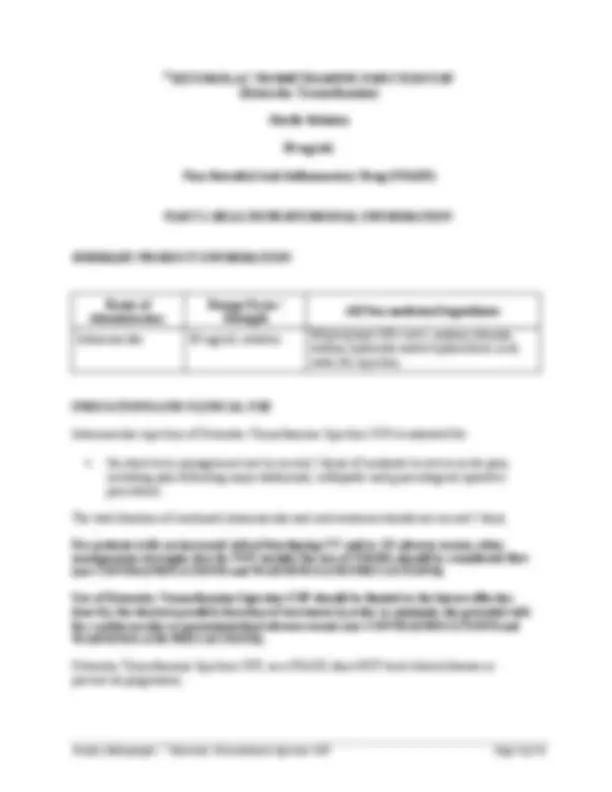
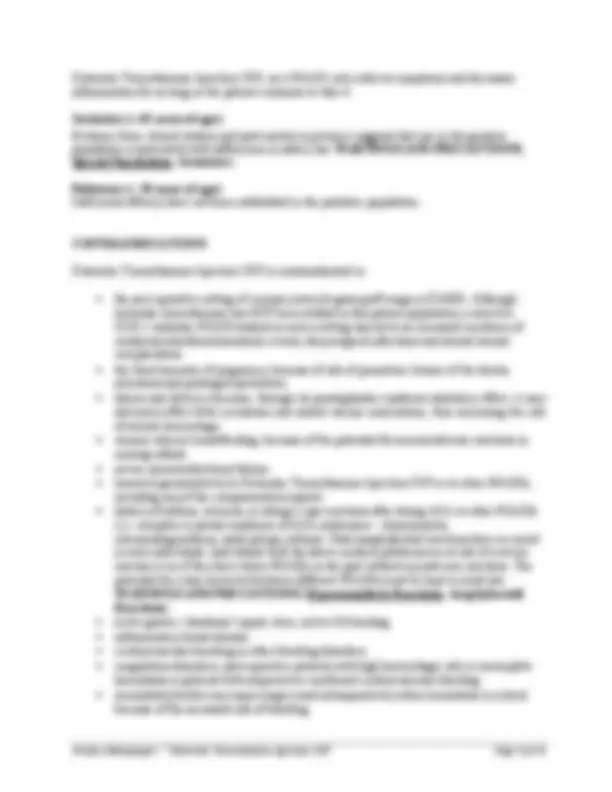
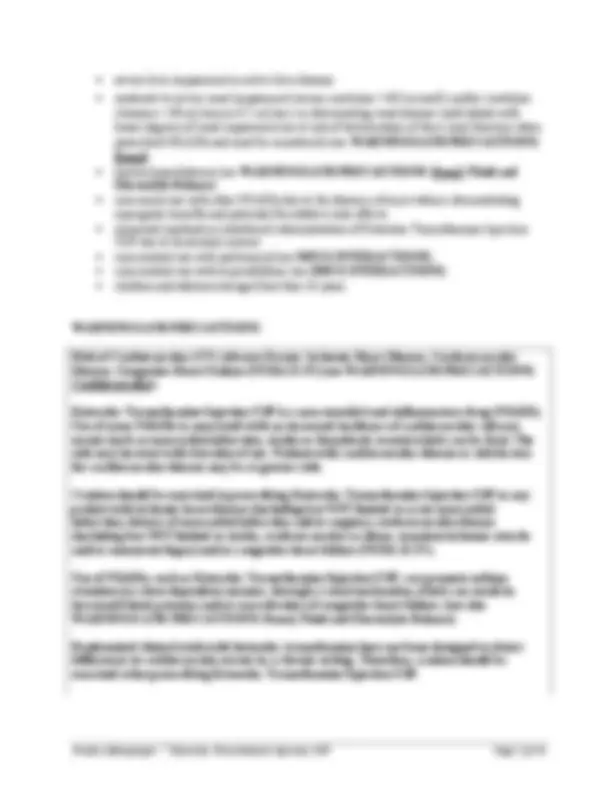
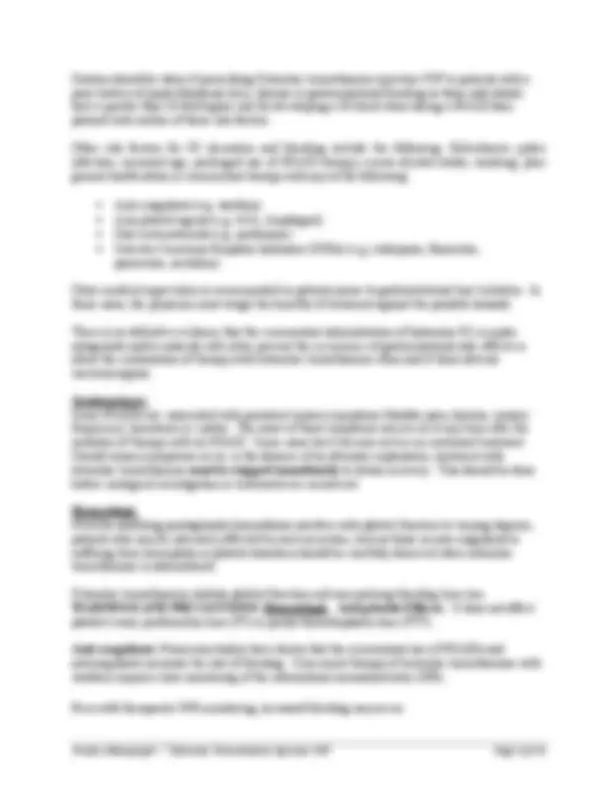

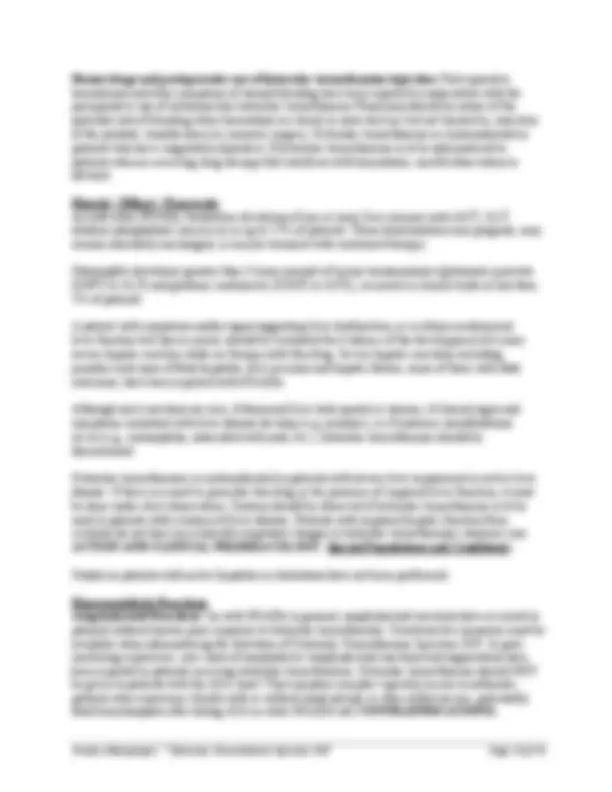
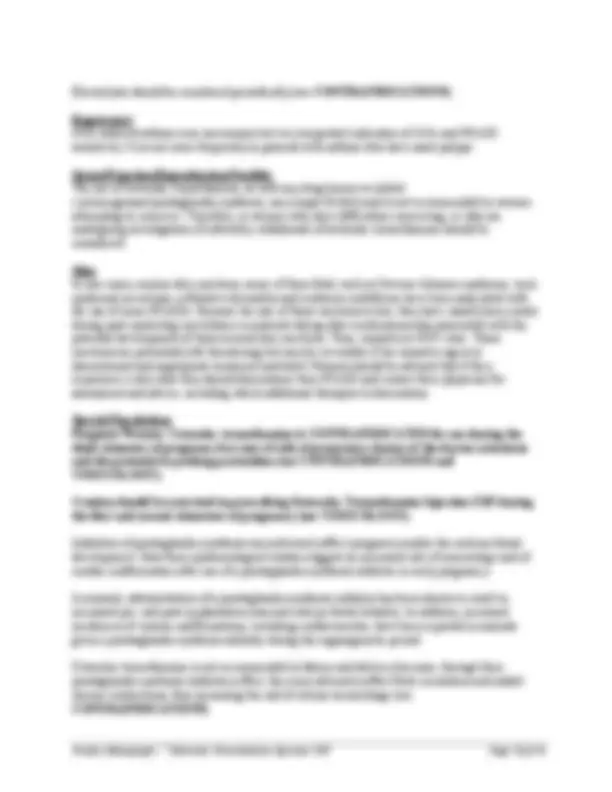
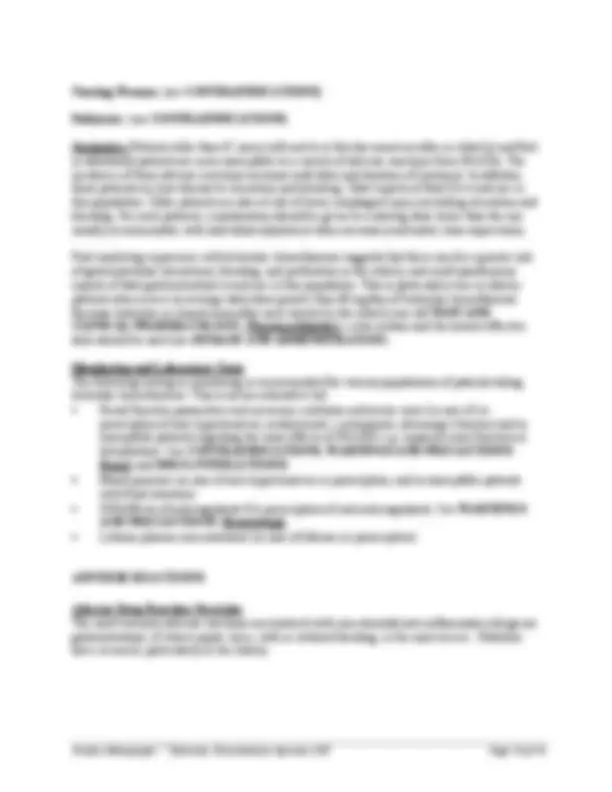

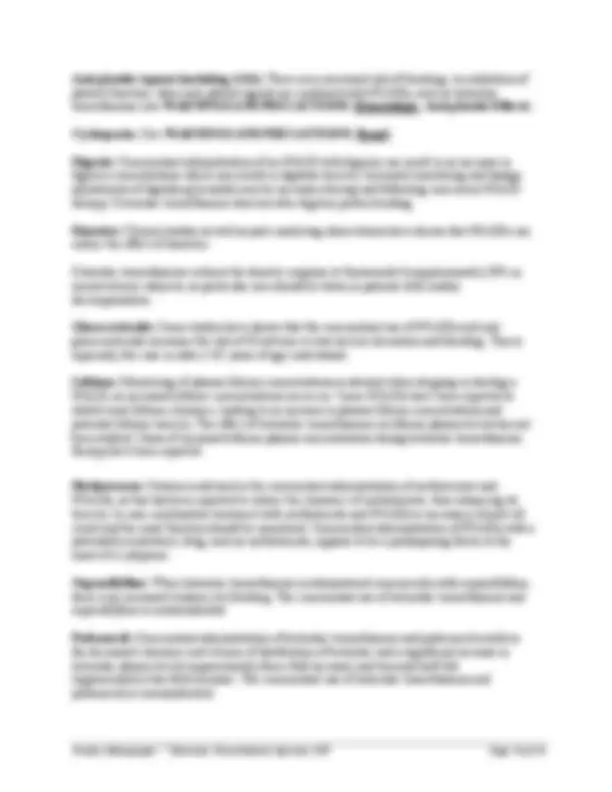
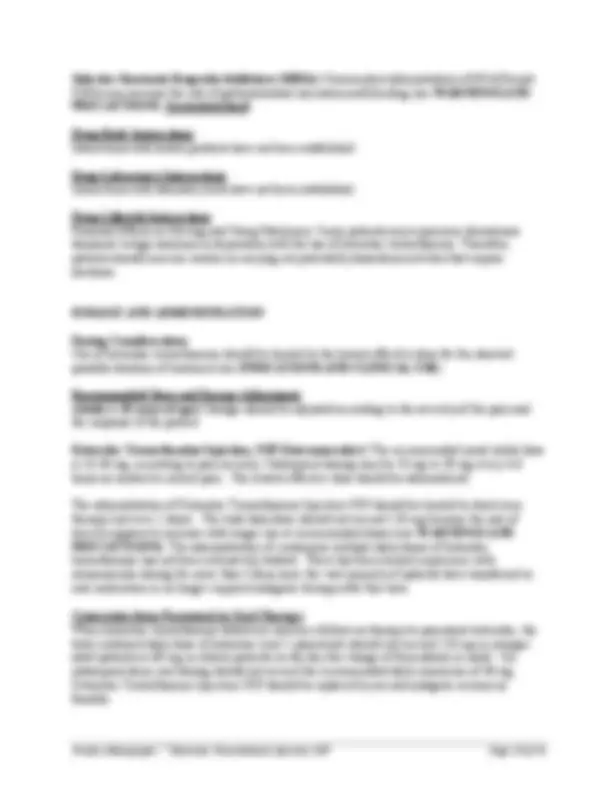
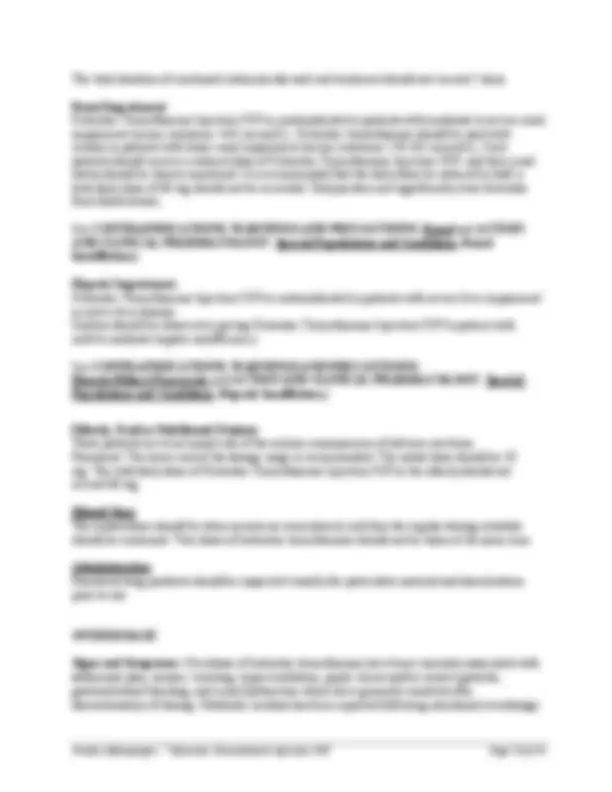
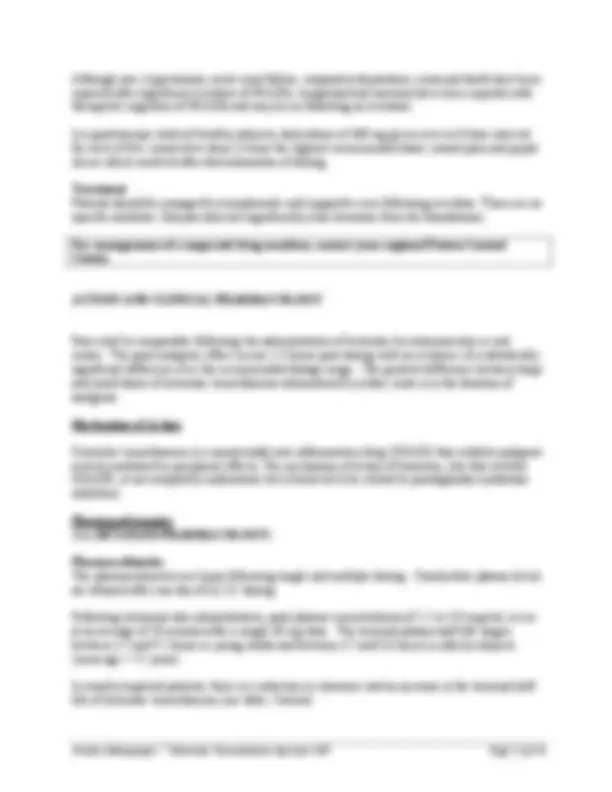
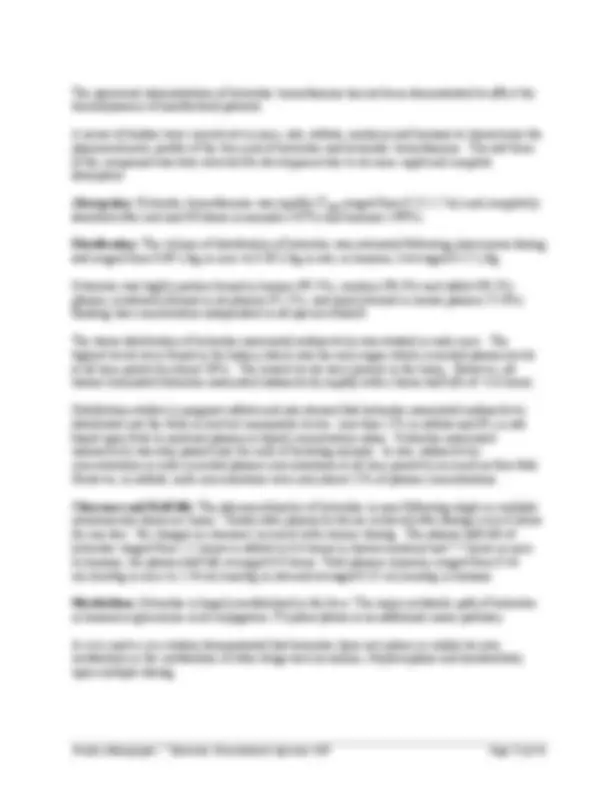
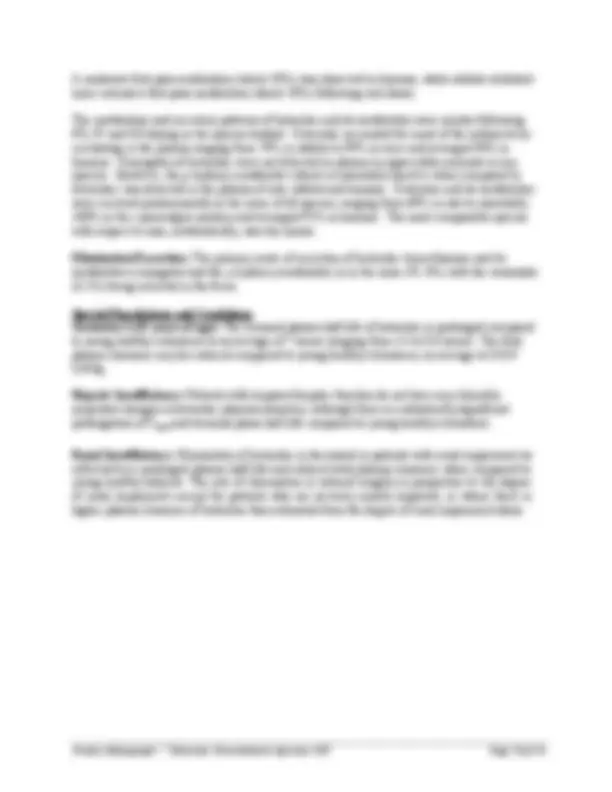
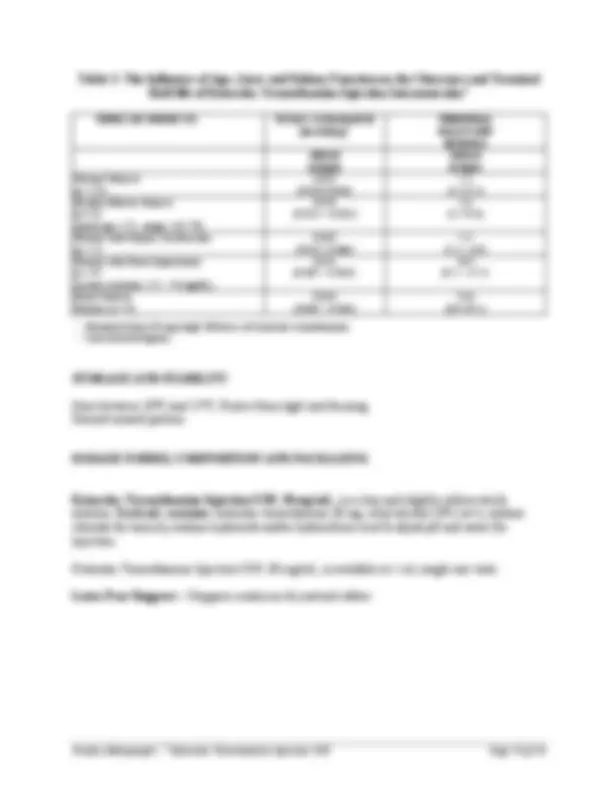
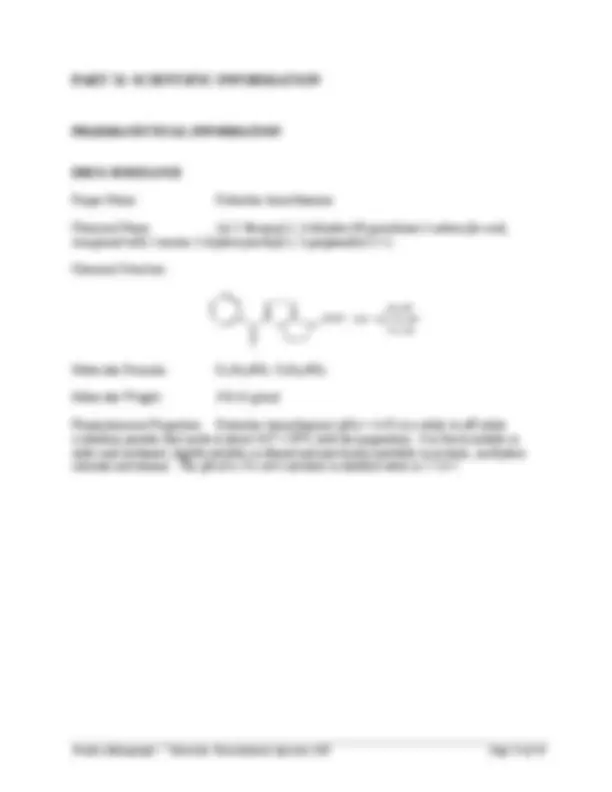
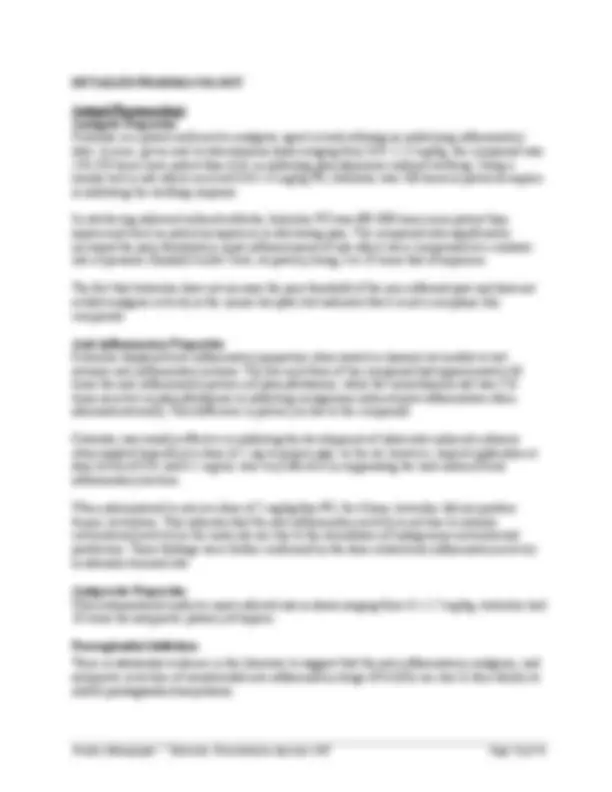
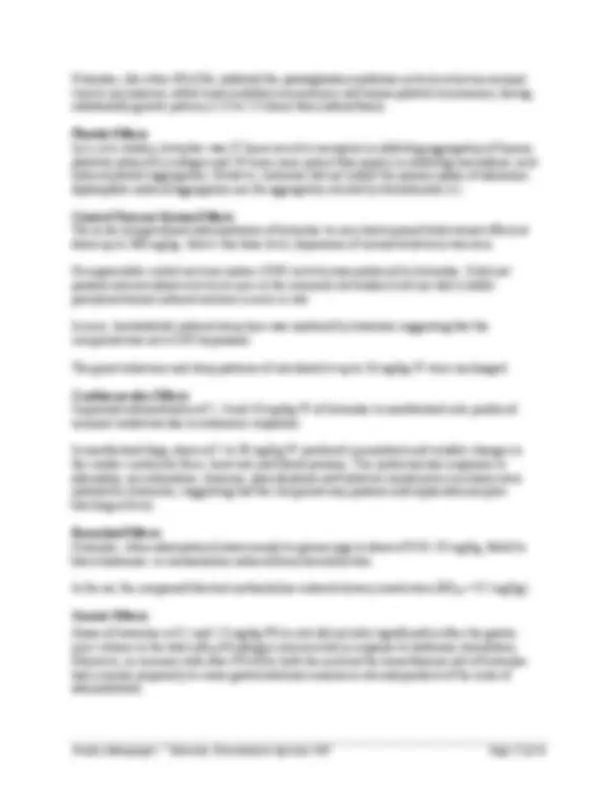
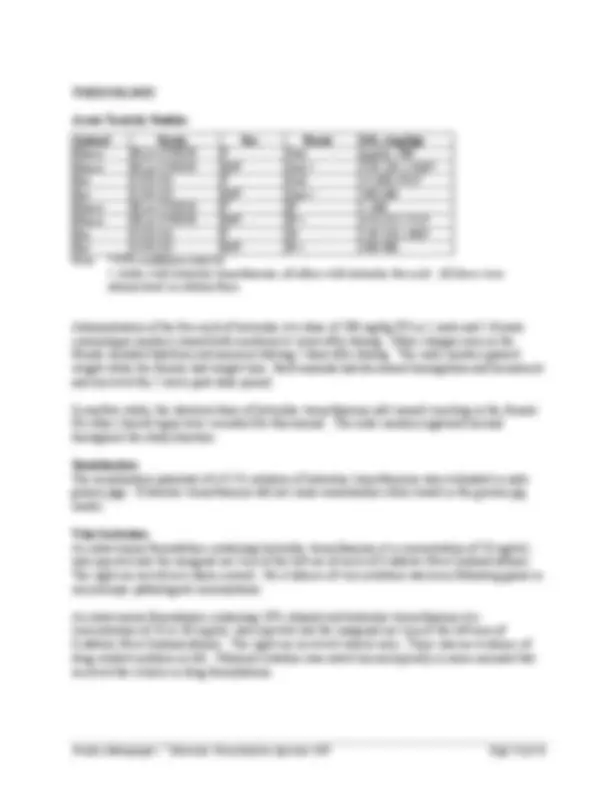
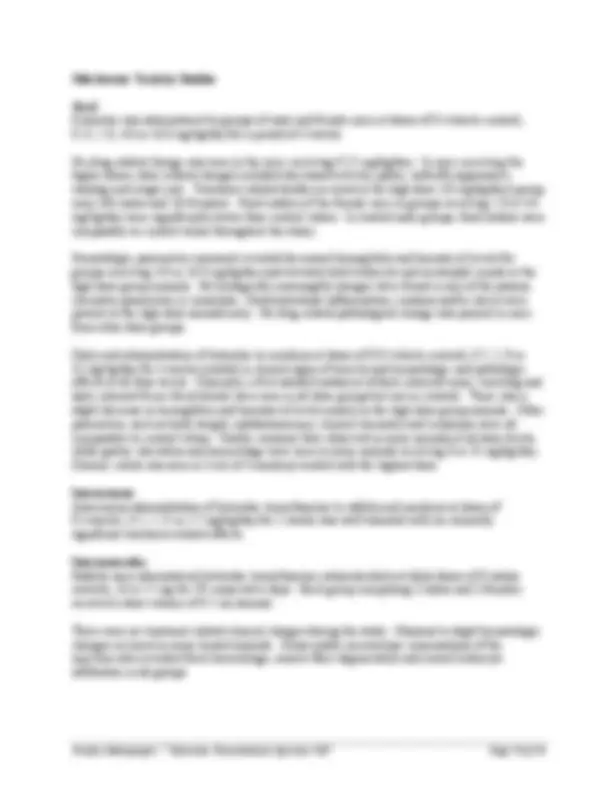

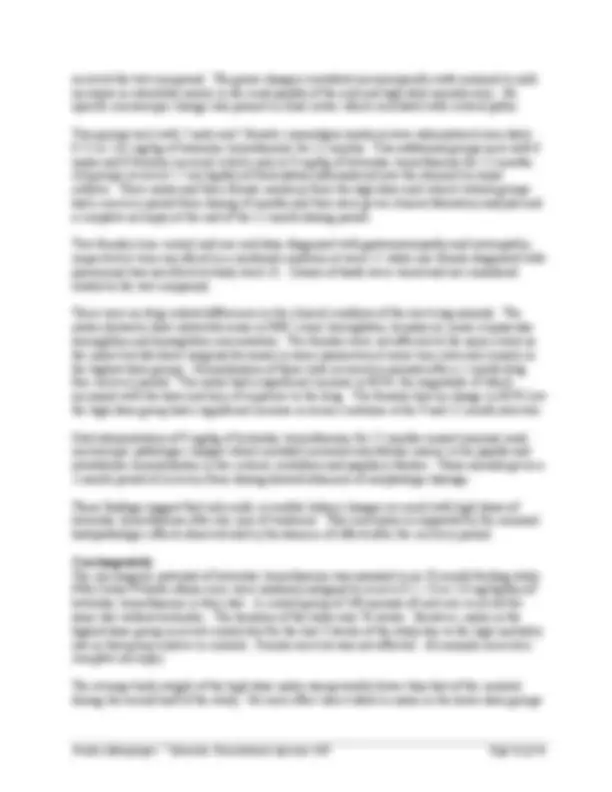
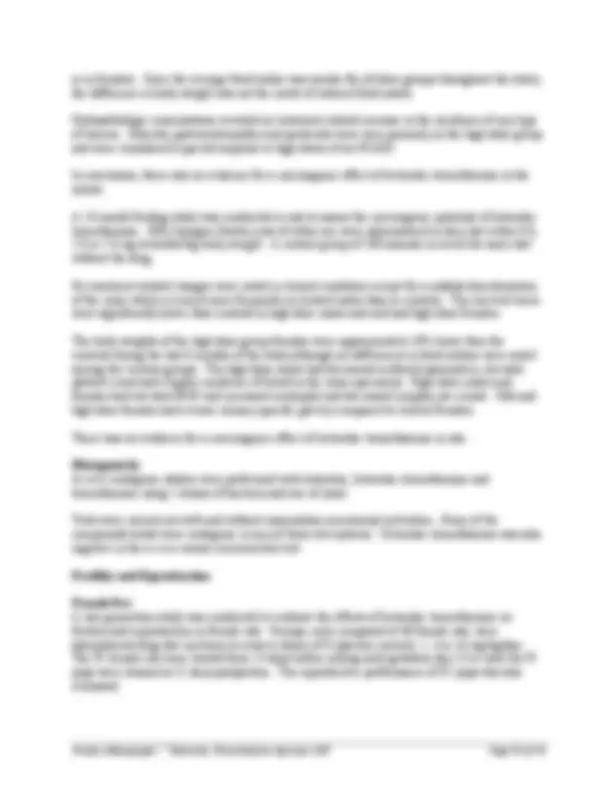

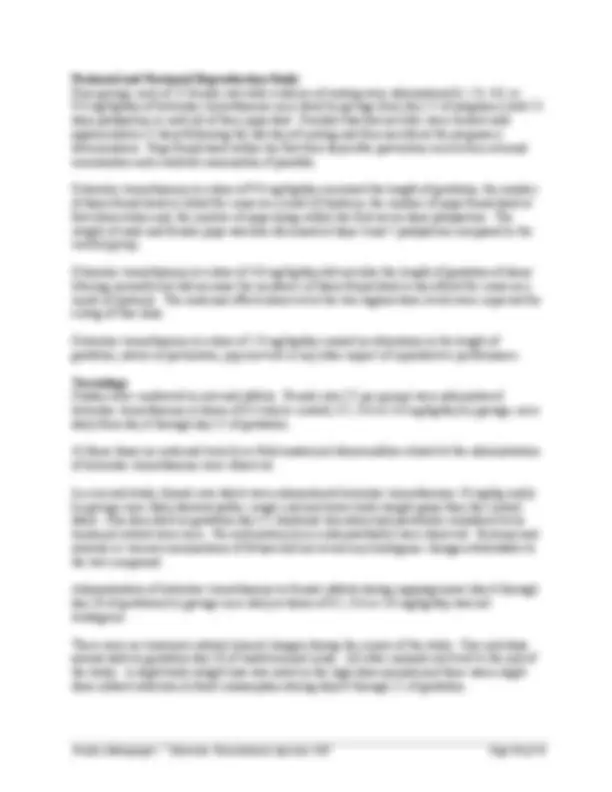

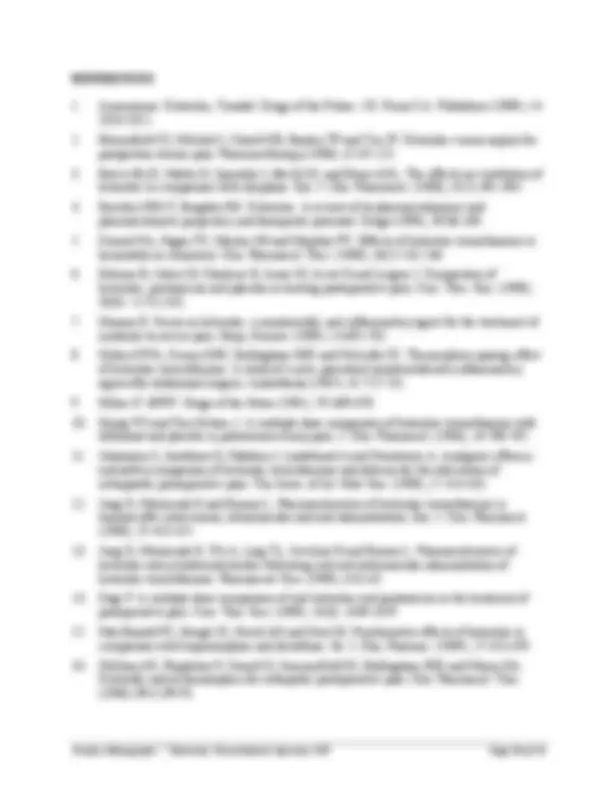
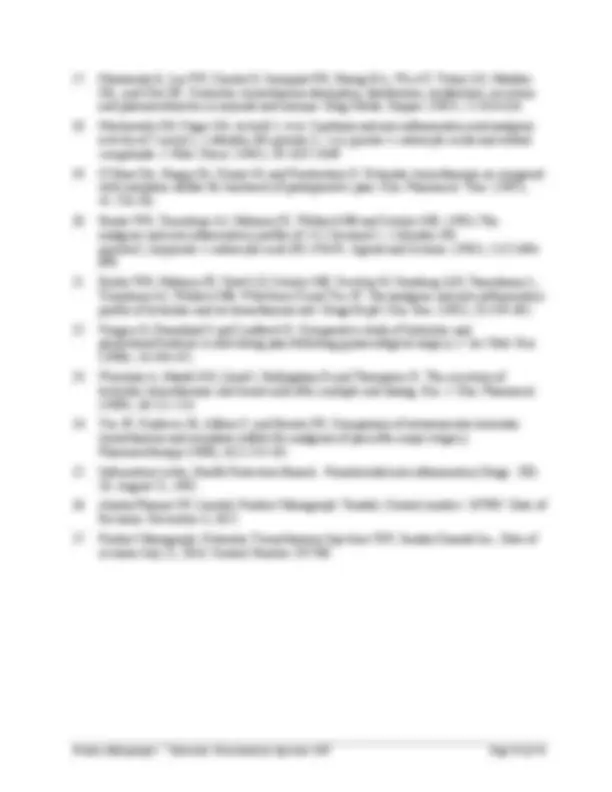
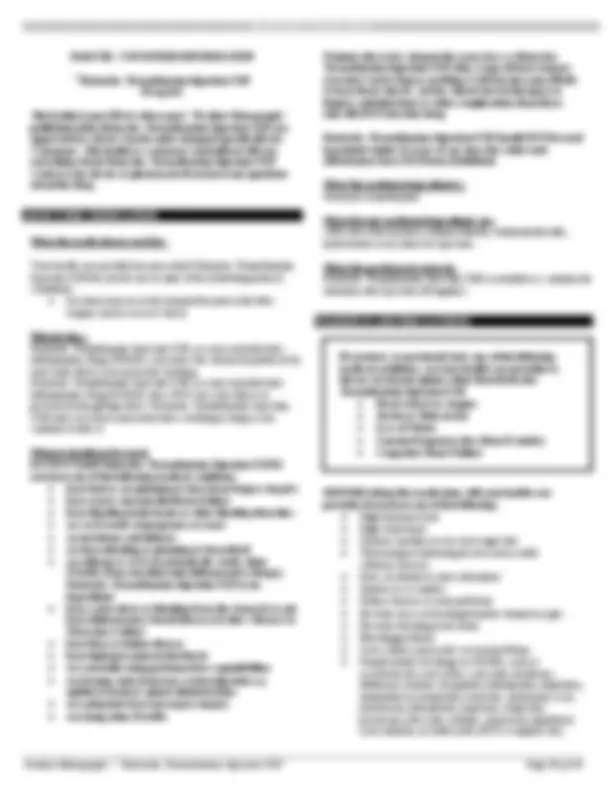
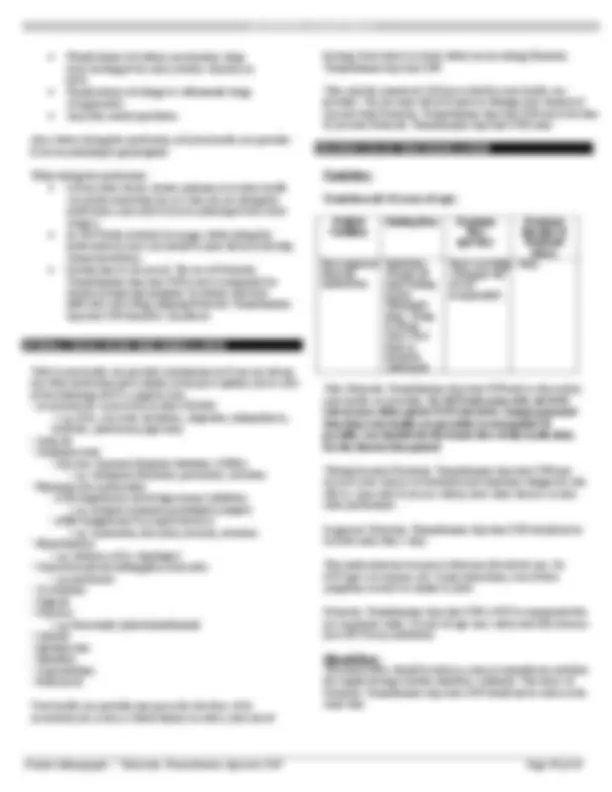
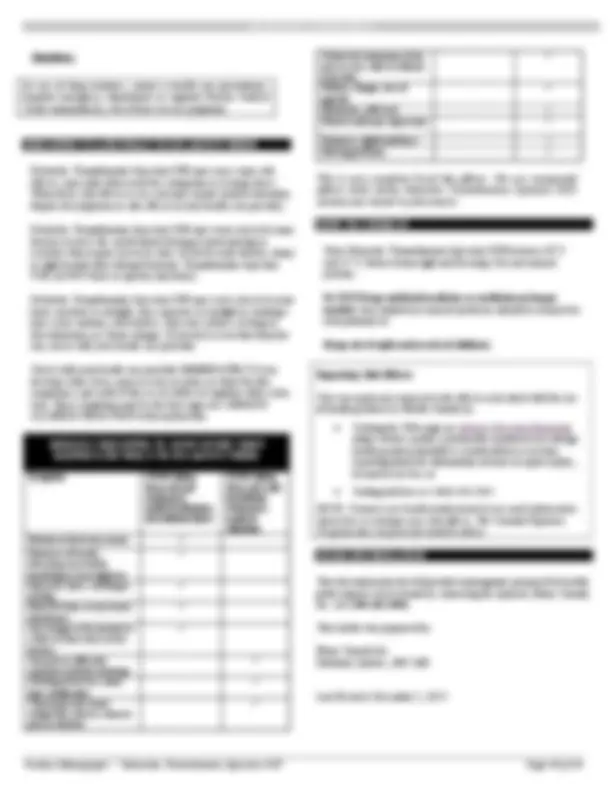


Study with the several resources on Docsity

Earn points by helping other students or get them with a premium plan


Prepare for your exams
Study with the several resources on Docsity

Earn points to download
Earn points by helping other students or get them with a premium plan
Community
Ask the community for help and clear up your study doubts
Discover the best universities in your country according to Docsity users
Free resources
Download our free guides on studying techniques, anxiety management strategies, and thesis advice from Docsity tutors
Information on the warnings and precautions related to the use of Ketorolac Tromethamine, a non-steroidal anti-inflammatory drug (NSAID). The document highlights the increased risk of gastrointestinal adverse events, renal toxicity, and hematologic toxicity associated with the use of this drug. It also mentions the potential drug interactions and the need for monitoring and laboratory tests for patients taking Ketorolac Tromethamine.
What you will learn
Typology: Exercises
1 / 40

This page cannot be seen from the preview
Don't miss anything!

































Pr
(Ketorolac Tromethamine)
Sterile Solution
30 mg/mL
Non-Steroidal Anti-Inflammatory Drug (NSAID)
Pfizer Canada Inc. 17300 Trans-Canada Highway Kirkland, Québec H9J 2M
Date of Revision: December 1, 2017
Submission Control No: 209949
Ketorolac Tromethamine Injection USP, as a NSAID, only relieves symptoms and decreases inflammation for as long as the patient continues to take it.
Geriatrics (> 65 years of age):
Evidence from clinical studies and post-market experience suggests that use in the geriatric population is associated with differences in safety (see WARNINGS AND PRECAUTIONS , Special Populations , Geriatrics ).
Pediatrics (< 18 years of age): Safety and efficacy have not been established in the pediatric population.
Ketorolac Tromethamine Injection USP is contraindicated in:
the peri-operative setting of coronary artery bypass graft surgery (CABG). Although ketorolac tromethamine has NOT been studied in this patient population, a selective COX-2 inhibitor NSAID studied in such a setting has led to an increased incidence of cardiovascular/thromboembolic events, deep surgical infections and sternal wound complications the third trimester of pregnancy, because of risk of premature closure of the ductus arteriosus and prolonged parturition labour and delivery because, through its prostaglandin synthesis inhibitory effect, it may adversely affect fetal circulation and inhibit uterine musculature, thus increasing the risk of uterine hemorrhage. women who are breastfeeding, because of the potential for serious adverse reactions in nursing infants severe uncontrolled heart failure known hypersensitivity to Ketorolac Tromethamine Injection USP or to other NSAIDs, including any of the components/excipients history of asthma, urticaria, or allergic-type reactions after taking ASA or other NSAIDs (i.e. complete or partial syndrome of ASA-intolerance - rhinosinusitis, urticaria/angioedema, nasal polyps, asthma). Fatal anaphylactoid reactions have occurred in such individuals. Individuals with the above medical problems are at risk of a severe reaction even if they have taken NSAIDs in the past without any adverse reactions. The potential for cross-reactivity between different NSAIDs must be kept in mind (see WARNINGS AND PRECAUTIONS : Hypersensitivity Reactions , Anaphylactoid Reactions ). active gastric / duodenal / peptic ulcer, active GI bleeding inflammatory bowel disease. cerebrovascular bleeding or other bleeding disorders coagulation disorders, post-operative patients with high hemorrhagic risk or incomplete hemostasis in patients with suspected or confirmed cerebrovascular bleeding. immediately before any major surgery and intraoperatively when hemostasis is critical because of the increased risk of bleeding
severe liver impairment or active liver disease moderate to severe renal impairment (serum creatinine >442 mcmol/L and/or creatinine clearance <30 mL/min or 0.5 mL/sec) or deteriorating renal disease (individuals with lesser degrees of renal impairment are at risk of deterioration of their renal function when prescribed NSAIDs and must be monitored) (see WARNINGS AND PRECAUTIONS : Renal ). known hyperkalemia (see WARNINGS AND PRECAUTIONS : Renal , Fluid and Electrolyte Balance ) concurrent use with other NSAIDs due to the absence of any evidence demonstrating synergistic benefits and potential for additive side effects neuraxial (epidural or intrathecal) administration of Ketorolac Tromethamine Injection USP due to its alcohol content. concomitant use with probenecid (see DRUG INTERACTIONS ). concomitant use with oxpentifylline (see DRUG INTERACTIONS ). children and adolescents aged less than 18 years.
Risk of Cardiovascular (CV) Adverse Events: Ischemic Heart Disease, Cerebrovascular Disease, Congestive Heart Failure (NYHA II-IV) (see WARNINGS AND PRECAUTIONS: Cardiovascular).
Ketorolac Tromethamine Injection USP is a non-steroidal anti-inflammatory drug (NSAID). Use of some NSAIDs is associated with an increased incidence of cardiovascular adverse events (such as myocardial infarction, stroke or thrombotic events) which can be fatal. The risk may increase with duration of use. Patients with cardiovascular disease or risk factors for cardiovascular disease may be at greater risk.
Caution should be exercised in prescribing Ketorolac Tromethamine Injection USP to any patient with ischemic heart disease (including but NOT limited to acute myocardial infarction, history of myocardial infarction and/or angina), cerebrovascular disease (including but NOT limited to stroke, cerebrovascular accident, transient ischemic attacks and/or amaurosis fugax) and/or congestive heart failure (NYHA II-IV).
Use of NSAIDs, such as Ketorolac Tromethamine Injection USP, can promote sodium retention in a dose-dependent manner, through a renal mechanism, which can result in increased blood pressure and/or exacerbation of congestive heart failure. (see also WARNINGS AND PRECAUTIONS: Renal, Fluid and Electrolyte Balance)
Randomized clinical trials with ketorolac tromethamine have not been designed to detect differences in cardiovascular events in a chronic setting. Therefore, caution should be exercised when prescribing Ketorolac Tromethamine Injection USP.
Use of NSAIDs, such as ketorolac tromethamine, can lead to new hypertension or can worsen pre-existing hypertension, either of which may increase the risk of cardiovascular events as described above. Thus blood pressure should be monitored regularly. Consideration should be given to discontinuing ketorolac tromethamine should hypertension either develop or worsen with its use.
Use of NSAIDs, such as ketorolac tromethamine, can induce fluid retention and edema, and may exacerbate congestive heart failure, through a renally-mediated mechanism (see WARNINGS AND PRECAUTIONS : Renal , Fluid and Electrolyte Balance ).
For patients with a high risk of developing an adverse CV event, other management strategies that do NOT include the use of NSAIDs should be considered first. To minimize the potential risk for an adverse CV event, the lowest effective dose should be used for the shortest possible duration.
Endocrine and Metabolism Corticosteroids: ketorolac tromethamine is NOT a substitute for corticosteroids. It does not treat corticosteroid insufficiency. Abrupt discontinuation of corticosteroids may lead to exacerbation of corticosteroid-responsive illness. Patients on prolonged corticosteroid therapy should have their therapy tapered slowly if a decision is made to discontinue corticosteroids (see DRUG INTERACTIONS : Drug-Drug Interactions , Glucocorticoids ).
Gastrointestinal Serious GI toxicity (sometimes fatal), such as peptic/duodenal ulceration, inflammation, perforation, obstruction and gastrointestinal bleeding, can occur at any time, with or without warning symptoms, in patients treated with NSAIDs, such as ketorolac tromethamine. Minor upper GI problems, such as dyspepsia, commonly occur at any time. Health care providers should remain alert for ulceration and bleeding in patients treated with ketorolac tromethamine, even in the absence of previous GI tract symptoms. Most spontaneous reports of fatal GI events are in elderly or debilitated patients and therefore special care should be taken in treating this population. The incidence of these complications increases with increasing dose. To minimize the potential risk for an adverse GI event, the lowest effective dose should be used for the shortest possible duration. For high risk patients, alternate therapies that do not involve NSAIDs should be considered (see WARNINGS AND PRECAUTIONS : Special Populations , Geriatrics ). Patients should be informed about the signs and/or symptoms of serious GI toxicity and instructed to discontinue using Ketorolac Tromethamine Injection USP and seek emergency medical attention if they experience any such symptoms. The utility of periodic laboratory monitoring has NOT been demonstrated, nor has it been adequately assessed. Most patients who develop a serious upper GI adverse event on NSAID therapy have no symptoms. Upper GI ulcers, gross bleeding or perforation, caused by NSAIDs appear to occur in approximately 1% of patients treated for 3- months and in about 2-4% of patients treated for one year. These trends continue, thus increasing the likelihood of developing a serious GI event at some time during the course of therapy. Even short-term therapy has its risks.
Caution should be taken if prescribing Ketorolac tromethamine injection USP to patients with a prior history of peptic/duodenal ulcer, disease or gastrointestinal bleeding as these individuals have a greater than 10-fold higher risk for developing a GI bleed when taking a NSAID than patients with neither of these risk factors.
Other risk factors for GI ulceration and bleeding include the following: Helicobacter pylori infection, increased age, prolonged use of NSAID therapy, excess alcohol intake, smoking, poor general health status or concomitant therapy with any of the following:
Anti-coagulants (e.g. warfarin) Anti-platelet agents (e.g. ASA, clopidogrel) Oral corticosteroids (e.g. prednisone) Selective Serotonin Reuptake Inhibitors (SSRIs) (e.g. citalopram, fluoxetine, paroxetine, sertraline)
Close medical supervision is recommended in patients prone to gastrointestinal tract irritation. In these cases, the physician must weigh the benefits of treatment against the possible hazards.
There is no definitive evidence that the concomitant administration of histamine H2-receptor antagonists and/or antacids will either prevent the occurrence of gastrointestinal side effects or allow the continuation of therapy with ketorolac tromethamine when and if these adverse reactions appear.
Genitourinary Some NSAIDs are associated with persistent urinary symptoms (bladder pain, dysuria, urinary frequency), hematuria or cystitis. The onset of these symptoms may occur at any time after the initiation of therapy with an NSAID. Some cases have become severe on continued treatment. Should urinary symptoms occur, in the absence of an alternate explanation, treatment with ketorolac tromethamine must be stopped immediately to obtain recovery. This should be done before urological investigation or treatments are carried out.
Hematologic NSAIDs inhibiting prostaglandin biosynthesis interfere with platelet function to varying degrees; patients who may be adversely affected by such an action, such as those on anti-coagulants or suffering from hemophilia or platelet disorders should be carefully observed when ketorolac tromethamine is administered.
Ketorolac tromethamine inhibits platelet function and may prolong bleeding time (see WARNINGS AND PRECAUTIONS : Hematologic , Anti-platelet Effects ). It does not affect platelet count, prothrombin time (PT) or partial thromboplastin time (PTT).
Anti-coagulants: Numerous studies have shown that the concomitant use of NSAIDs and anticoagulants increases the risk of bleeding. Concurrent therapy of ketorolac tromethamine with warfarin requires close monitoring of the international normalized ratio (INR).
Even with therapeutic INR monitoring, increased bleeding may occur.
Hemorrhage and perioperative use of ketorolac tromethamine injection: Post-operative hematomas and other symptoms of wound bleeding have been reported in association with the perioperative use of intramuscular ketorolac tromethamine.Physicians should be aware of the potential risk of bleeding when hemostasis is critical in cases such as, but not limited to, resection of the prostate, tonsillectomy or cosmetic surgery. Ketorolac tromethamine is contraindicated in patients who have coagulation disorders. If ketorolac tromethamine is to be administered to patients who are receiving drug therapy that interferes with hemostasis, careful observation is advised.
Hepatic / Biliary / Pancreatic As with other NSAIDs, borderline elevations of one or more liver enzyme tests (AST, ALT, alkaline phosphatase) may occur in up to 15% of patients. These abnormalities may progress, may remain essentially unchanged, or may be transient with continued therapy.
Meaningful elevations (greater than 3 times normal) of serum transaminases (glutamate pyruvate [SGPT or ALT] and glutamic oxaloacetic [SGOT or AST]), occurred in clinical trials in less than 1% of patients.
A patient with symptoms and/or signs suggesting liver dysfunction, or in whom an abnormal liver function test has occurred, should be evaluated for evidence of the development of a more severe hepatic reaction while on therapy with this drug. Severe hepatic reactions including jaundice and cases of fatal hepatitis, liver necrosis and hepatic failure, some of them with fatal outcomes, have been reported with NSAIDs.
Although such reactions are rare, if abnormal liver tests persist or worsen, if clinical signs and symptoms consistent with liver disease develop (e.g. jaundice), or if systemic manifestations occur (e.g., eosinophilia, associated with rash, etc.), ketorolac tromethamine should be discontinued.
Ketorolac tromethamine is contraindicated in patients with severe liver impairment or active liver disease. If there is a need to prescribe this drug in the presence of impaired liver function, it must be done under strict observation. Caution should be observed if ketorolac tromethamine is to be used in patients with a history of liver disease. Patients with impaired hepatic function from cirrhosis do not have any clinically important changes in ketorolac tromethamine clearance (see ACTION AND CLINICAL PHARMACOLOGY : Special Populations and Conditions ).
Studies in patients with active hepatitis or cholestasis have not been performed.
Hypersensitivity Reactions Anaphylactoid Reactions: As with NSAIDs in general, anaphylactoid reactions have occurred in patients without known prior exposure to ketorolac tromethamine. Counteractive measures must be available when administering the first dose of Ketorolac Tromethamine Injection USP. In post- marketing experience, rare cases of anaphylactic/ anaphylactoid reactions and angioedema have been reported in patients receiving ketorolac tromethamine. Ketorolac tromethamine should NOT be given to patients with the ASA-triad. This symptom complex typically occurs in asthmatic patients who experience rhinitis with or without nasal polyps, or who exhibit severe, potentially fatal bronchospasm after taking ASA or other NSAIDs (see CONTRAINDICATIONS ).
ASA-Intolerance: Ketorolac tromethamine should NOT be given to patients with complete or partial syndrome of ASA-intolerance (rhinosinusitis, urticaria/angioedema, nasal polyps, asthma) in whom asthma, anaphylaxis, urticaria/angioedema, rhinitis or other allergic manifestations are precipitated by ASA or other NSAIDs. Fatal anaphylactoid reactions have occurred in such individuals. As well, individuals with the above medical problems are at risk of a severe reaction even if they have taken NSAIDs in the past without any adverse reaction (see CONTRAINDICATIONS ).
Cross-sensitivity: Patients sensitive to one NSAID may be sensitive to any of the other NSAIDs as well.
Serious skin reactions: (See WARNINGS AND PRECAUTIONS : Skin )
Immune (See WARNINGS AND PRECAUTIONS : Infection , Aseptic Meningitis )
Infection Ketorolac tromethamine, in common with other NSAIDs, may mask signs and symptoms of an underlying infectious disease.
Aseptic Meningitis: Rarely, with some NSAIDs, the symptoms of aseptic meningitis (stiff neck, severe headaches, nausea and vomiting, fever or clouding of consciousness) have been observed. Patients with autoimmune disorders (systemic lupus erythematosus, mixed connective tissue diseases, etc.) seem to be pre-disposed. Therefore, in such patients, the health care provider must be vigilant to the development of this complication.
Neurologic Some patients may experience drowsiness, dizziness, blurred vision, vertigo, tinnitus, hearing loss, insomnia or depression with the use of NSAIDs, such as ketorolac tromethamine. If patients experience such adverse reaction(s), they should exercise caution in carrying out activities that require alertness
Ophthalmologic Blurred and/or diminished vision has been reported with the use of NSAIDs. If such symptoms develop, ketorolac tromethamine should be discontinued and an ophthalmologic examination performed. Ophthalmologic examination should be carried out at periodic intervals in any patient receiving ketorolac tromethamine for an extended period of time.
Peri-Operative Considerations
(See CONTRAINDICATIONS : Coronary Artery Bypass Graft Surgery, see WARNINGS AND PRECAUTIONS : Hematologic , Hemorrhage and perioperative use of ketorolac tromethamine injection )
Psychiatric (See WARNINGS AND PRECAUTIONS : Neurologic )
Electrolytes should be monitored periodically (see CONTRAINDICATIONS ).
Respiratory ASA-induced asthma is an uncommon but very important indication of ASA and NSAID sensitivity. It occurs more frequently in patients with asthma who have nasal polyps.
Sexual Function/Reproduction/Fertility The use of ketorolac tromethamine, as with any drug known to inhibit cyclooxygenase/prostaglandin synthesis, may impair fertility and is not recommended in women attempting to conceive. Therefore, in women who have difficulties conceiving, or who are undergoing investigation of infertility, withdrawal of ketorolac tromethamine should be considered.
Skin In rare cases, serious skin reactions, some of them fatal, such as Stevens-Johnson syndrome, toxic epidermal necrolysis, exfoliative dermatitis and erythema multiforme have been associated with the use of some NSAIDs. Because the rate of these reactions is low, they have usually been noted during post-marketing surveillance in patients taking other medications also associated with the potential development of these serious skin reactions. Thus, causality is NOT clear. These reactions are potentially life threatening but may be reversible if the causative agent is discontinued and appropriate treatment instituted. Patients should be advised that if they experience a skin rash they should discontinue their NSAID and contact their physician for assessment and advice, including which additional therapies to discontinue.
Special Populations Pregnant Women: K etorolac tromethamine is CONTRAINDICATED for use during the third trimester of pregnancy because of risk of premature closure of the ductus arteriosus and the potential to prolong parturition (see CONTRAINDICATIONS and TOXICOLOGY).
Caution should be exercised in prescribing Ketorolac Tromethamine Injection USP during the first and second trimesters of pregnancy (see TOXICOLOGY).
Inhibition of prostaglandin synthesis may adversely affect pregnancy and/or the embryo-foetal development. Data from epidemiological studies suggest an increased risk of miscarriage and of cardiac malformation after use of a prostaglandin synthesis inhibitor in early pregnancy.
In animals, administration of a prostaglandin synthesis inhibitor has been shown to result in increased pre- and post-implantation loss and embryo-foetal lethality. In addition, increased incidences of various malformations, including cardiovascular, have been reported in animals given a prostaglandin synthesis inhibitor during the organogenetic period.
Ketorolac tromethamine is not recommended in labour and delivery because, through their prostaglandin synthesis inhibitory effect, they may adversely affect fetal circulation and inhibit uterine contractions, thus increasing the risk of uterine hemorrhage (see CONTRAINDICATIONS ).
Nursing Women: (see CONTRAINDICATIONS )
Pediatrics : (see CONTRAINDICATIONS )
Geriatrics: Patients older than 65 years (referred to in this document as older or elderly) and frail or debilitated patients are more susceptible to a variety of adverse reactions from NSAIDs. The incidence of these adverse reactions increases with dose and duration of treatment. In addition, these patients are less tolerant to ulceration and bleeding. Most reports of fatal GI events are in this population. Older patients are also at risk of lower esophageal injury including ulceration and bleeding. For such patients, consideration should be given to a starting dose lower than the one usually recommended, with individual adjustment when necessary and under close supervision.
Post-marketing experience with ketorolac tromethamine suggests that there may be a greater risk of gastrointestinal ulcerations, bleeding, and perforation in the elderly, and most spontaneous reports of fatal gastrointestinal events are in this population. This is particularly true in elderly patients who receive an average daily dose greater than 60 mg/day of ketorolac tromethamine. Because ketorolac is cleared somewhat more slowly by the elderly (see ACTION AND CLINICAL PHARMACOLOGY , Pharmacokinetics ), extra caution and the lowest effective dose should be used (see DOSAGE AND ADMINISTRATION ).
Monitoring and Laboratory Tests The following testing or monitoring is recommended for various populations of patients taking ketorolac tromethamine. This is not an exhaustive list. Renal function parameters such as serum creatinine and serum urea (in case of co- prescription of anti-hypertensives, methotrexate, cyclosporine, adrenergic blockers and in susceptible patients regarding the renal effects of NSAIDS e.g. impaired renal function or dehydration). See CONTRAINDICATIONS , WARNINGS AND PRECAUTIONS : Renal , and DRUG INTERACTIONS. Blood pressure (in case of anti-hypertensives co-prescription, and in susceptible patients with fluid retention) INR/effects of anticoagulants (Co-prescription of oral anticoagulants). See WARNINGS AND PRECAUTIONS : Hematologic. Lithium plasma concentrations (in case of lithium co-prescription)
Adverse Drug Reaction Overview The most common adverse reactions encountered with non-steroidal anti-inflammatory drugs are gastrointestinal, of which peptic ulcer, with or without bleeding, is the most severe. Fatalities have occurred, particularly in the elderly.
Body as a Whole: Asthenia, fever, back pain, chills, pain, neck pain
Special Senses: Taste perversion, tinnitus, blurred vision, diplopia, retinal hemorrhage
Musculo-skeletal System: Myalgia, twitching
Respiratory System: Asthma, cough increased, dyspnea, epistaxis, hiccup, rhinitis
Skin and Appendages: Pruritus, rash, subcutaneous hematoma, skin disorder
Urogenital System: Dysuria, urinary retention, oliguria, increased urinary frequency, vaginitis
Metabolic/Nutritional Disorders: Edema, hypokalemia, hypovolemia
Hematologic and Lymphatic System: Anemia, coagulation disorder, purpura
Abnormal Hematologic and Clinical Chemistry Findings Elevations of blood urea nitrogen (BUN) and creatinine have been reported in clinical trials with ketorolac.
Post-Market Adverse Drug Reactions Additional reports of adverse events temporally associated with ketorolac tromethamine during worldwide post-marketing experience are included below. Because these events are reported voluntarily from a population of uncertain size, it is not always possible to reliably estimate their frequency or clearly establish a causal relationship to ketorolac tromethamine exposure.
The following post-marketing adverse experiences have been reported for patients who have received ketorolac tromethamine (tablets and injection):
Renal Events: Acute renal failure, flank pain with or without hematuria and/or azotemia, nephritis, hyponatremia, hyperkalemia, hemolytic uremic syndrome, urinary retention
Hypersensitivity Reactions: Bronchospasm, laryngeal edema, asthma, hypotension, flushing, rash, anaphylaxis, angioedema and anaphylactoid reactions. Such reactions have occurred in patients with no prior history of hypersensitivity
Gastrointestinal Events: Gastrointestinal hemorrhage, peptic ulceration, gastrointestinal perforation, pancreatitis, melena, esophagitis, hematemesis
Hematologic Events: Postoperative wound hemorrhage, rarely requiring blood transfusion (see WARNINGS AND PRECAUTIONS ), thrombocytopenia, epistaxis, leukopenia, hematomata, increased bleeding time
Central Nervous System: Convulsions, abnormal dreams, hallucinations, hyperkinesia, hearing loss, aseptic meningitis, extrapyramidal symptoms, psychotic reactions
Hepatic Events: Hepatitis, liver failure, cholestatic jaundice
Cardiovascular: Pulmonary edema, hypotension, flushing, bradycardia
Reproductive, female: Infertility
Dermatology: Lyell’s syndrome, Stevens-Johnson syndrome, exfoliative dermatitis, maculopapular rash, urticaria
Body as Whole: Infection
Urogenital: Interstitial nephritis, nephrotic syndrome, raised serum urea and creatinine
Drug-Drug Interactions Acetylsalicylic acid (ASA) or other NSAIDs: The use of ketorolac tromethamine in addition to most NSAIDs, including over the counter ones (such as Ibuprofen) for analgesic and/or anti- inflammatory effects is usually contraindicated because of the absence of any evidence demonstrating synergistic benefits and the potential for additive adverse reactions.
The exception is the use of low dose ASA for cardiovascular protection, when another NSAID is being used for its analgesic/anti-inflammatory effect, keeping in mind that combination NSAID therapy is associated with additive adverse reactions.
Some NSAIDs (e.g. ibuprofen) may interfere with the anti-platelet effects of low dose ASA, possibly by competing with ASA for access to the active site of cyclooxygenase-1. In vitro studies indicated that, at therapeutic concentrations of salicylates (300 mcg/mL), the binding of ketorolac tromethamine was reduced from approximately 99.2% to 97.5% representing a potential two-fold increase in unbound ketorolac tromethamine plasma levels.
Antacids: There is no definitive evidence that the concomitant administration of histamine H2- receptor antagonists and/or antacids will either prevent the occurrence of gastrointestinal side effects or allow the continuation of ketorolac tromethamine therapy when and if these adverse reactions appear.
Anti-coagulants: (See WARNINGS AND PRECAUTIONS : Hematologic , Anticoagulants ).
Anti-hypertensives: NSAIDs may diminish the anti-hypertensive effects of angiotensin converting enzyme (ACE) inhibitors.
Combinations of ACE inhibitors, angiotensin-II antagonists, or diuretics with NSAIDs might have an increased risk for acute renal failure and hyperkalemia. Blood pressure and renal function (including electrolytes) should be monitored more closely in this situation, as occasionally there can be a substantial increase in blood pressure.
Selective Serotonin Reuptake Inhibitors (SSRIs): Concomitant administration of NSAIDs and SSRIs may increase the risk of gastrointestinal ulceration and bleeding (see WARNINGS AND PRECAUTIONS : Gastrointestinal ).
Drug-Herb Interactions Interactions with herbal products have not been established.
Drug-Laboratory Interactions Interactions with laboratory tests have not been established.
Drug-Lifestyle Interactions Potential Effects on Driving and Using Machinery: Some patients may experience drowsiness dizziness vertigo insomnia or depression with the use of ketorolac tromethamine. Therefore, patients should exercise caution in carrying out potentially hazardous activities that require alertness.
Dosing Considerations Use of ketorolac tromethamine should be limited to the lowest effective dose for the shortest possible duration of treatment (see INDICATIONS AND CLINICAL USE ).
Recommended Dose and Dosage Adjustment Adults (>18 years of age): Dosage should be adjusted according to the severity of the pain and the response of the patient.
Ketorolac Tromethamine Injection, USP (Intramuscular): The recommended usual initial dose is 10-30 mg, according to pain severity. Subsequent dosing may be 10 mg to 30 mg every 4- hours as needed to control pain. The lowest effective dose should be administered.
The administration of Ketorolac Tromethamine Injection USP should be limited to short-term therapy (not over 2 days). The total daily dose should not exceed 120 mg because the risk of toxicity appears to increase with longer use at recommended doses (see WARNINGS AND PRECAUTIONS ). The administration of continuous multiple daily doses of ketorolac tromethamine has not been extensively studied. There has been limited experience with intramuscular dosing for more than 3 days since the vast majority of patients have transferred to oral medication or no longer required analgesic therapy after this time.
Conversion from Parenteral to Oral Therapy When ketorolac tromethamine tablets are used as a follow-on therapy to parenteral ketorolac, the total combined daily dose of ketorolac (oral + parenteral) should not exceed 120 mg in younger adult patients or 60 mg in elderly patients on the day the change of formulation is made. On subsequent days, oral dosing should not exceed the recommended daily maximum of 40 mg. Ketorolac Tromethamine Injection USP should be replaced by an oral analgesic as soon as feasible.
The total duration of combined intramuscular and oral treatment should not exceed 5 days.
Renal Impairment Ketorolac Tromethamine Injection USP is contraindicated in patients with moderate to severe renal impairment (serum creatinine >442 mcmol/L). Ketorolac tromethamine should be used with caution in patients with lesser renal impairment (serum creatinine 170-442 mcmol/L). Such patients should receive a reduced dose of Ketorolac Tromethamine Injection USP, and their renal status should be closely monitored. It is recommended that the daily dose be reduced by half; a total daily dose of 60 mg should not be exceeded. Dialysis does not significantly clear ketorolac from blood stream.
See CONTRAINDICATIONS , WARNINGS AND PRECAUTIONS : Renal and ACTION AND CLINICAL PHARMACOLOGY : Special Populations and Conditions , Renal Insufficiency.
Hepatic Impairment Ketorolac Tromethamine Injection USP is contraindicated in patients with severe liver impairment or active liver disease. Caution should be observed in giving Ketorolac Tromethamine Injection USP to patient with mild to moderate hepatic insufficiency.
See CONTRAINDICATIONS , WARNINGS AND PRECAUTIONS : Hepatic/Biliary/Pancreatic and ACTION AND CLINICAL PHARMACOLOGY : Special Populations and Conditions , Hepatic Insufficiency.
Elderly, Frail or Debilitated Patients These patients are at increased risk of the serious consequences of adverse reactions. Parenteral: The lower end of the dosage range is recommended. The initial dose should be 10 mg. The total daily dose of Ketorolac Tromethamine Injection USP in the elderly should not exceed 60 mg.
Missed Dose The missed dose should be taken as soon as remembered, and then the regular dosing schedule should be continued. Two doses of ketorolac tromethamine should not be taken at the same time.
Administration Parenteral drug products should be inspected visually for particulate material and discoloration prior to use.
Signs and Symptoms: Overdoses of ketorolac tromethamine have been variously associated with abdominal pain, nausea, vomiting, hyperventilation, peptic ulcers and/or erosive gastritis, gastrointestinal bleeding, and renal dysfunction which have generally resolved after discontinuation of dosing. Metabolic acidosis has been reported following intentional overdosage.